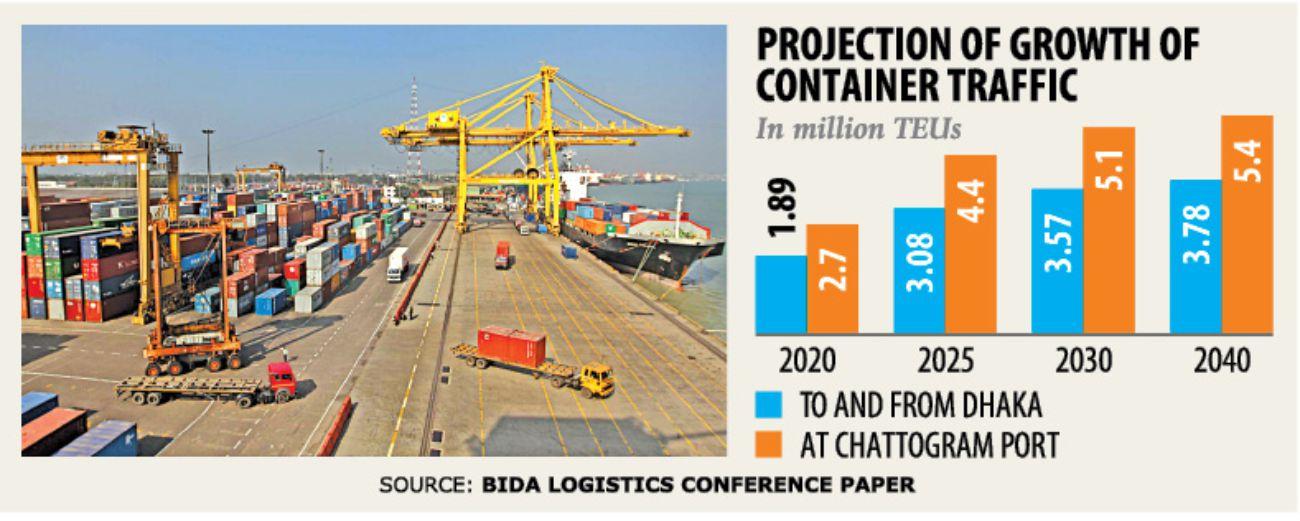Logistics network needs urgent improvement: study

Bangladesh needs to drastically improve its logistics network to handle the fast growing inbound and outbound cargo and container movement in line with the country’s remarkable economic growth.
By 2021, the country would be dealing with 35 million TEUs (twenty-foot equivalent unit) of cargo and 53 million TEUs by 2025, which is more than double of what it handles now, according to a report of the Bangladesh Supply Chain Management Society (BSCMS).
The report was unveiled at a conference styled ‘Logistics in Bangladesh: challenges and future readiness’, jointly organised by the Bangladesh Investment Development Authority (BIDA) and BSCMS at the capital’s Radisson Blu Dhaka Water Garden hotel yesterday.
The Chattogram port and the Mongla port are the two dominant operational seaports in Bangladesh, with the former handling 90 percent of the country’s cargo movement.
As a result, the Chattogram port is bursting at the seams, while the port in the southwest coastal belt remains underutilised. The Mongla port has the capacity to handle 70,000 TEUs a year but in fiscal 2016-17 it handled 26,952 TEUs, down 36 percent from a year earlier.
The rail transportation could be in a position to enhance its capacity to cater the increased export-import cargo handling by the Chattogram Port by more than 10 percent to recapture its legacy from the current dilapidated performance, the report said.
“It is estimated that the existing four-lane road capacity of the Dhaka-Chattogram Highway will come to exhaustion before 2025.”
Export and import via airway is increasing at a double-digit rate, the report said.
“Import cargo handling at the airport is now in deplorable condition as the shade and warehouse space is inadequate.”
The existing warehouse with racking facility is not being used fully due to lack of handling equipment and tracking system.
“The yard space and warehouses for export cargo shall not be sufficient to match the evident yearly growth,” the report said, adding that if the current growth is sustained all facility will be exhausted by 2025.
Bangladesh will need 26.74 million square feet of additional warehouse space by fiscal 2021-22.
Currently, the demand for warehouse space, mainly for storing imported and exportable goods, near the ports is 41.5 million square feet. And in the next four years, the demand will increase to 68.24 million square feet, according to the report.
The capacity of the implemented and planned waterway-based inland container depots and terminals are assumed to remain at 0.24 million TEUs and come to exhaustion by 2025.
Subsequently, the government needs to address and bring significant steps to support the logistics sector and boost its growth in the times to come, the report said.
It can put in place a comprehensive national logistics policy for a larger and holistic improvement in the sector.
A number of countries have developed similar blueprints and the policymakers can learn from their experiences, it said.
The growth targets will not be achieved unless cost-effective, hi-tech based logistic equipment and quality infrastructure are not ensured, said Salman F Rahman, the prime minister’s private industry and investment advisor, while addressing the opening session of the conference.
The logistic sector will have to improve for faster growth of business, he added.
Naquib Khan, president of BSCMS, presided over the programme.
M Aminul Islam, executive chairman of BIDA; Mohamamd Abul Kalam Azad, principal coordinator of SDG affairs at the Prime Minister’s Office; and Mominul Islam, managing director and chief executive officer of IPDC, also spoke.
